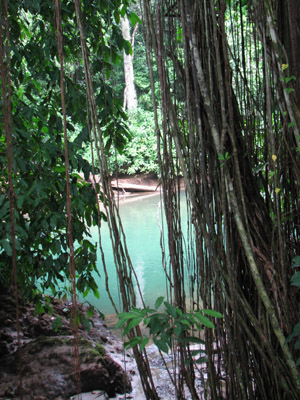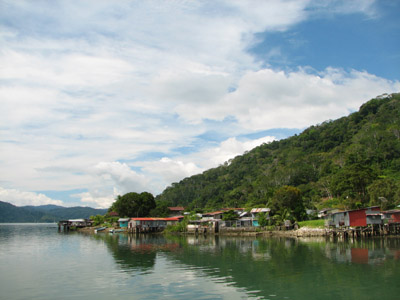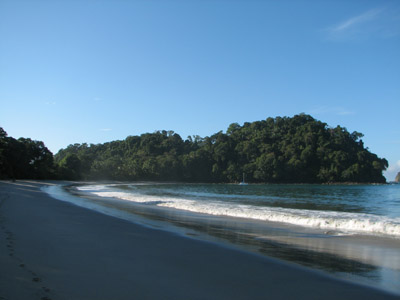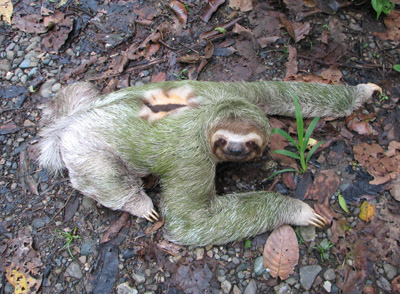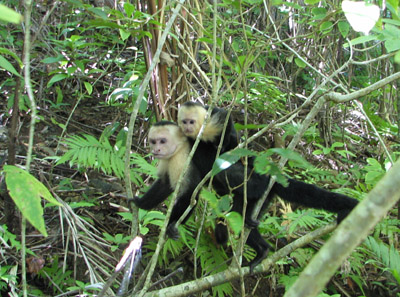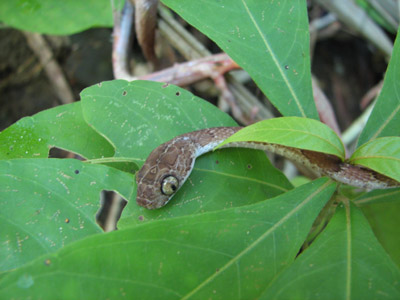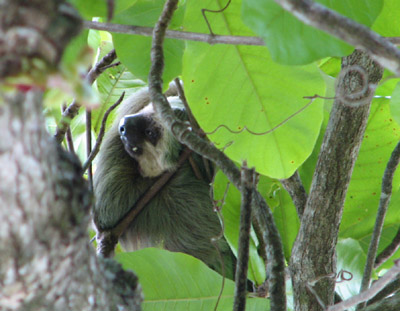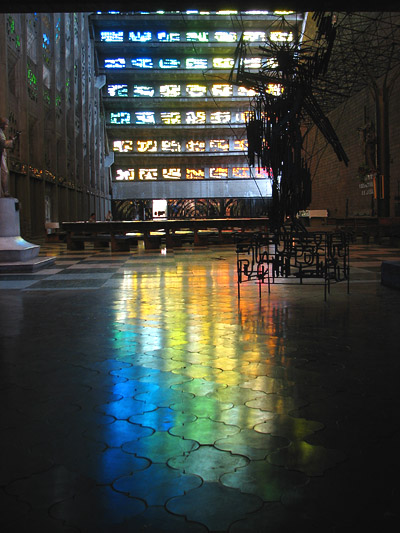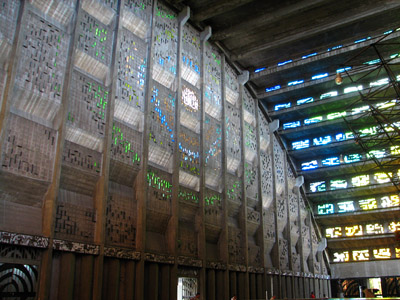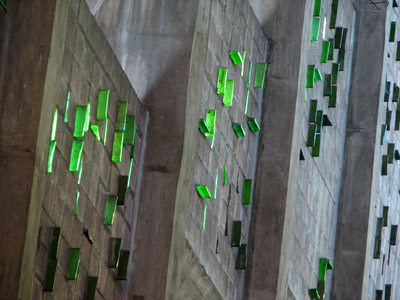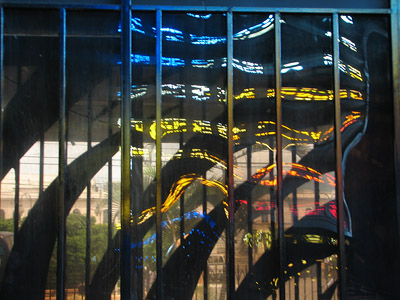I may have mentioned a few thousand times about the dismaying blandness of Central American food, particularly after the richness and variety of Mexican cuisine. The mercados no longer offer a rainbow of hot peppers, even the ever-present chili poblano disappeared, only to be replaced by a lighter-green facsimile that has no apparent spice whatsoever. El Salvador cooking, however, in my vaguely biased opinion, is a bit more exciting in general but there is one shining gem that not only makes El Salvador a food destination, but nearly redeems all of Central America, just knowing this island of potential deliciousness exists. And this is the Pupusa.
Pupusas are like a stuffed tortilla, made either of corn or rice flour. We have found both rice and corn to be available nearly everywhere we’ve gone. They are about six inches in diameter, thick with fillings of cheese, beans, chicharrόn (fatty pork), or any combination thereof; a mixture of all three is called ‘revueltas.’ In San Salvador, you can often find cheese and ‘ayote,’ a grated squash, and these are particularly excellent. On the Estero, at Mar y Sol, we often ordered cheese and shrimp. Invariably it is served with ‘curtido,’ a shredded cabbage, carrot, and onion saurkraut-ish salad, as well as a mild tomato sauce. They cost from 25 cents on the street to 40 cents depending upon how ‘fancy’ the restaurant is; I can eat two. Frequently I think I want to eat three, but experience has taught me that I will be sorry and to always stick with two.
In San Salvador, particularly near the center or around the market, there are pupusa stands set up everywhere you look. They line the sidewalks of certain streets, one after another; some cooking corn pupusas and some cooking rice ones. Despite my corn intolerance, I broke down once (for the sake of science) and ate a couple of corn pupusas. I have to say the corn are perhaps a little better—I find they have a richer flavor, but typically I was forced for the sake of sanity and well-being to stick to the rice pupusas and many people prefer these to the corn.
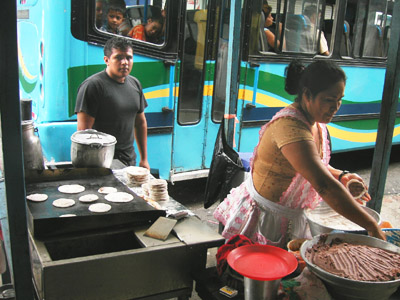
This woman had her pupusa stand set up a few blocks from the hotel we typically stayed in, near the technical university in San Salvador. The number of pupusa stands is staggering in this section of town and since she was on a side street off the major busy diesel-choked bus street, we generally made a beeline for her stand the moment we exited our hotel in the mornings. (Even so, avoiding busses is nearly impossible in this city, as you can see.)
You can see the large aluminum bowls of fillings; she makes two different sizes, the six-incher and another smaller one, of around four inch’s diameter. Most people seem to order the smaller size in the mornings, possibly because it is easier to eat with your hands. Pupusas are typically eaten with the hands; utensils are used only to scoop the curtido out of the jar. We would usually try to ask if they had any sort of utensils (we are not as skilled at not making a mess if we eat them with our hands; besides, they are always hot as hell to touch when they come off the grill) and this would be met with confused looks like, ‘just what are you going to DO with that fork?’ or sometimes a lengthy search resulting in one bent-up aluminum fork and one dusty plastic coffee spoon. We actually took to carrying around a couple of plastic forks wherever we went in case we needed a pupusa or two and this always killed the pupusa ladies; they would nudge each other at our curious gringo habits, we would give them a big goofy grin, and they would burst into raucous laughter.
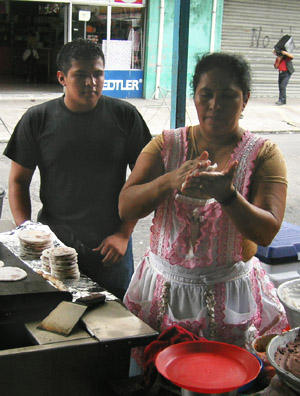
She was either assisted by her son or her husband (today is the son).
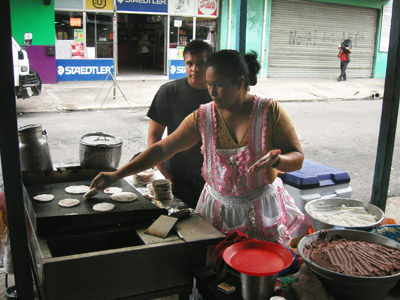
The aluminum canister on the left is the coffee urn. Coffee, albeit brewed (not instant), is weak and much sugar is added. Sounds gross but we sort of developed a taste for it when we were in the city. The pupusa stands usually also have an urn of hot chocolate in the mornings. (Note the elaborate market apron; market women in El Salvador invariably wear one of these aprons, although generally they don’t have the bib part, just the skirt.)
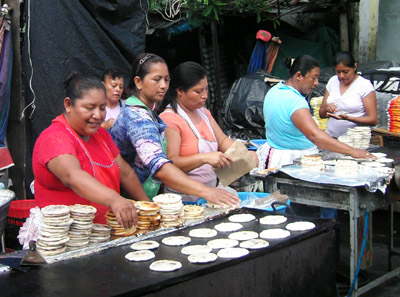
This was our other favorite street pupusa stand; they were located a block off the central square in the market and they always had cheese and ayote pupusas. The only problem is that they did not have tables set up—you had to take your pupusa to go wrapped in brown paper with a little plastic baggie of curtido and a baggie of tomato sauce.
PUPUSAS
(Dough)
* Rice flour or corn flour (masa). I’ve only tried this with rice flour, which can probably be found in the US in any sort of Co-op or Whole Foods type stores, at least.
* Water
To prepare:
For two pupusas per person, use 1/4 to 1/3 cup of rice flour (or masa, presumably) per person. Add water and mix until you have a dryish pasty consistency. Imagine something you might be able to ball up in your hands… That’s it; it’s insanely easy and I recommend making all the fillings, curtido, and tomato sauces in advance (and in quantity) and then putting together the dough at the last minute whenever you want to cook them.
(Fillings)
* Cheese. Salvadorian cheese, ‘quesillo,’ is a soft melting cheese and either comes mixed with flower buds, called ‘loroco,’ or loroco is added. I have not achieved consistency perfection yet with the cheese, but you must chop and blend it somehow with the flower buds until it becomes creamy, even sort of pasty. A possible US substitution might be a soft mozzarella, chopped and smashed to a more pasty consistency; chives could be mixed in or maybe minced squash blossoms would be good. (You need the pasty consistency when assembling the pupusas.)
* Beans. Basically, use refried beans. I would never make these from scratch due to the insane amount of time required and the profusion of ready-made refried bean products out there, but one obviously could. Again, you want a nice pasty consistency—not too watery.
* ChicharrÏŒn. I have done my best to ignore what is actually in chicharrÏŒn, but I must face my demons sometime so here it is. I thought it was always pork skin, but the consistency of the chicharrÏŒn we got in pupusas often seemed to have a shredded thing going, so I would say use some sort of fatty porky product and you will be safe. Chop the chicharrÏŒn into a pan with chopped onion and tomato and simmer until the veggies are soft and the majority of water has boiled off. Blend the mixture into a paste. (You might start to notice a trend here with the paste thing.)
* Ayote. I never found a recipe during online searches for ayote pupusas but I would guess that it could be prepared thusly: shred some sort of squash, like yellow crook-neck or you could try to find ‘ayote’ in a latin grocery. Simmer in a pan with a little oil and salt until it is tender and much of the water has evaporated. You can probably avoid mashing this one to a paste and just leave it a limp shredded heap.
Obviously this is an insane amount of preparation to make a few pupusas revueltas. Making the fillings you wish ahead of time and then keeping them in the refrigerator makes the most sense; you can then put together a pupusa or two whenever you feel like it. I’ve only personally made the cheese ones.
(Curtido)
* Cabbage. Shred into very fine strips; I try to keep mine in the 1/8-inch width range and maybe an inch or two long.
* Carrot. Peel and coarsely shred a carrot or two (depending upon how much curtido you intend to make). You want the carrot to add a sprinkle of color to the cabbage mixture, not equal parts; a 1:5 ratio perhaps.
* White onion. Chop some onion into thin slices; proportion-wise, you want less onion than carrot.
* Jalapeno. Slice some jalapeno (to taste).
* White vinegar.
* Water.
* Fresh oregano, coarsely chopped.
* Salt.
To prepare:
Admittedly, I have not been able to get my curtido to taste “right.†I don’t know why because the ingredients seem so straightforward. I highly recommend locating a Salvadorian woman and consulting with her about ingredients and ratios. At any rate, mix the vegetables and cover with vinegar and water, mixed half-and-half. Mix in an attractive amount of oregano; enough to taste it but don’t overwhelm the curtido. Add a pinch or two of salt (to taste) and set this aside in the refrigerator overnight or at least for several hours for the flavors to blend. Taste and adjust salt if necessary afterwards; you could add a pinch or two of sugar if the vinegar is too strong. Many of the curtido jars sitting on tables in San Salvador had a yellow color, as if a pinch of tumeric was added; I never found out what this was. The approximate amount of curtido required for one pupusa varies with individual tastes but I would estimate one cup of curtido per four pupusas.
(Tomato Salsa)
* Roma tomatoes. Or you could use canned.
* Chopped white onion. Some.
* Chopped green bell pepper. Some.
* Bouillon; chicken or vegetable, etc.
* Salt to taste (watch out if the bouillon used is already salted).
To prepare:
Simmer the tomato with the onion and pepper in broth until all is soft. Blend in a blender to create a smooth consistency. You want the final result to have a consistency somewhere between V-8 and pasta sauce.
ASSEMBLY
Set up all your bowls of preparation ingredients: dough, fillings, and a small bowl of oil. Heat a dry flat-bottomed skillet to approximate pancake-cooking temperature. If you measured out the flour on a per-person basis, you might visually or physically divide up the dough with a knife so you get an even amount for each pupusa—that way you don’t end up with a runty pupusa at the end, like I always do.
Rub some oil on your hands and grab up a blob of dough, rolling it around into a ball and then flattening it slightly into a concave shape reminiscent of a giant red blood cell (pardon the metaphor). Scoop up a smaller blob of filling (you want maybe a filling center 1/3 or 1/4 the volume of the dough)—either all cheese, half cheese and ayote, half cheese and beans, or revueltas: cheese, beans, and chicharrόn. The Salvadorian ladies do not make any attempt to mix the ingredients inside the pupusa; they smear a bit of one, another, and then another filling and then get on with the forming of the patty. Having a nice paste consistency of your filling ingredients is key for smoothly forming the pupusa. Trying to keep air pockets minimal, gently close your red blood cell over the filling with your hand, turning the thing gently. Ideal is to have an even-walled ball of dough over the fillings before flattening it into a patty; the Salvadorian ladies tend to overestimate the amount of dough required, then fold it into a purse shape over the fillings pinching off the top of excess dough. Now, gently flatten the ball into your six-inch pupusa, taking care not to explode the filling contents out the outer dough.
Place it upon the grill and continue forming more pupusas. I usually cheat and use the grill to continue flattening my pupusas. Cook until the side has a mild browning—you want the heat high enough so that it doesn’t take so long the dough gets dried out but then you don’t want to burn it. Flip and finish cooking on the other side.
Serve hot pupusas with the curtido at room temperature and the tomato salsa heated slightly. The curtido is scooped over the top of the pupusa and then the salsa spooned over this. You could also put hot sauce on it as well (like Tobasco or Marie Sharp’s). You may eat it with a fork, if you must.
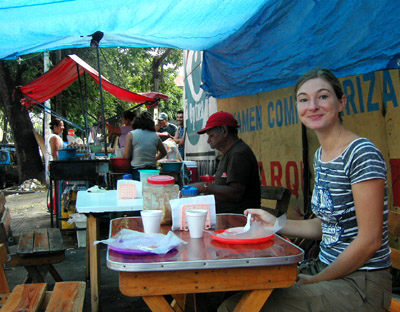
Decidedly pleased to have some pupusas in front of me.
